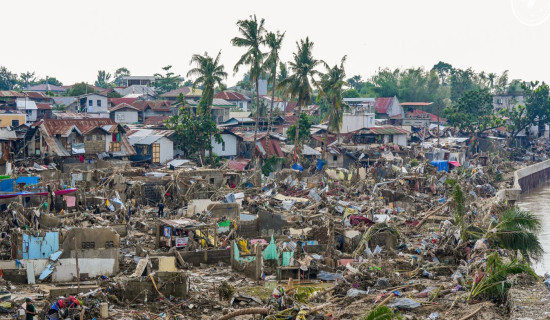- Tuesday, 11 November 2025
Migrating Demoiselle Cranes seen in Kailali's skies
By Avinash Chaudhary,Dhangadhi, Oct. 7: Demoiselle Cranes, locally known as Karyangkurung, have begun appearing in Nepal’s skies as they fly thousands of kilometres from the Arctic towards India each year.
To escape the winter, these birds migrate from northern China, Mongolia and Siberia, passing over Nepal on their way to India. They are commonly seen flying across the skies of Kailali, Kanchanpur and Bardiya before spending around six months in Rajasthan and Gujarat, India.
According to Krishna Chaudhary of Bhuiyanfanta, Kailari Rural Municipality-7, the cranes have been visible in the skies since the Dashain festival. He said thousands of them continue flying southwards in large flocks.
Although they fly high in the sky, their loud calls of “karyang-kurung” make them easy to recognise. They usually fly in a V-shaped formation. When the leading bird gets tired, another takes its place, while the rest follow behind in formation.
They migrate southwards in autumn, passing through Nepal via narrow Himalayan valleys such as the Kaligandaki and Karnali corridors.
Ornithologist Hirulal Dangoura explained that Demoiselle Cranes migrate across the country each year from September to November.
The main migration period is between 1 and 17 September, though this year the first sighting in the country was on 24 September.
The cranes enter Nepal via two routes -- one through Upper Mustang and the Dhaulagiri mountains, and the other through Dolpa. Birds coming through Upper Mustang follow the Bheri River Corridor, while those entering via Dolpa follow the Karnali Corridor towards India. They use places like Damodarkunda, Lomangthang, Chaile, Chuksang, Kagbeni, Tukuche, Marpha, etc. in the Mustang/Upper Mustang area for stopovers. On their journey to India, they fly nearly 4,896 kilometres over about 40 days. When returning northwards, they cover up to 6,034 kilometres, taking around 65 to 66 days.
After spending six months in India, the cranes return to Russia, Mongolia, and northern China, travelling via Pakistan, Kyrgyzstan and Afghanistan.
Globally, the Demoiselle Crane is listed by IUCN as least concern, because it has a large range and good population numbers in many places. However, some local populations or migration routes face threats which could affect them, experts said.
Habitat destruction and change are among the major threats to Demoiselle Cranes in Nepal. The conversion of farmland, along with the destruction or degradation of wetlands and riverbanks used during migration, reduces the safe spaces these birds rely on, according to experts.
In addition, changes in agricultural practices, such as burning crop residues and the use of pesticides, not only disturb their stopover and feeding sites but also reduce insect populations, an important food source for the cranes.






-original-thumb.jpg)










